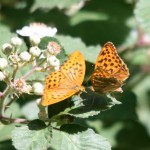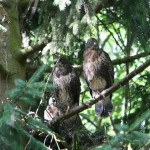On Wednesday 20 July 2011, Fred Taylor led a group of 20, RDNHS members and others, from the Bottle and Glass at Binfield Heath to woodland between Binfield Heath and Sonning Common, including Red Hill Wood. The walk progressed along ‘Bones Lane’ from the pub to the wood. Bones Lane is an ancient Pack Horse route between Henley and Binfield Heath. Large mature trees, including Oak, Elm, Field Maple and various fruit trees indicate the age of this route. Hazel trees carried a good crop, but these will go the same way as the woodland nuts when the squirrels get to them! The name, Bones Lane, may be a derivation from Bournes Farm at the start of the path, or from some old Barns set back a few hundred yards from the path and dating back 300 years or so. Bournes Farm, now just a yard and storage buildings, is owned, along with the woodland, by Phillimore Farms/Estate. The fields on both sides of the path are cultivated with broad beans for cattle food (and deer food). Previous crops have included various cereals, including millet. Two Fallow Deer were seen to the right, prior to the walk. The fields were infested with the blooms of one of the Chamomile family and at least two Skylarks were seen.
The woodland exhibits all the characteristics of an ‘unmanaged’ wood with areas of mixed plantation, ancient beech wood, mature scrub and alder / birch damp woodland. Fencing is non-existent or poorly maintained, allowing free movement of the larger mammals between the wood and surrounding fields.
1. Mature mixed plantation.
Planted some 40 years ago, there are 100ft plus high pines dominating, interspersed with over-shadowed beech. These conifers are up to 9ft in circumference and could have been felled ten years ago. The beech rarely exceed 9 inch diameter. Some tops of the larger pines have been blown off and other trees have blown down entirely. The beeches have extensive squirrel damage. The plastic trunk protectors used when they were planted are still lying around the woodland floor. Others have been grown over and are embedded in the timber of the trees. The importance of ‘bio-degradables’ was not understood in the 1960’s!! The wood and surrounding arable areas are used as a pheasant shoot. Field edges are usually planted with maize and large amounts of feed grain are used to rear the game birds through the winter. This encourages a good stock of ground mammals – mice and shrews, and this in turn, encourages the carnivores. In this mature woodland, heavily browsed by deer, there are large areas of clear under-canopy. Hence, the wood has four or five Tawny Owl territories and this first part of the walk always has a resident pair. Martin tried his ‘Hoot’, but only flushed a Sparrowhawk or Kestrel from a large oak at the corner of the wood.
2. Mature scrubby woodland.
The second part of the walk took us into mature scrubby woodland. The soil is gravelly and sandy, overlaying chalk. The mature trees are mainly a mix of sycamore and ash with some pines. The under-storey features extensive clumps of box and dogwood. The floor has much Dog’s Mercury, nettle and moss. The walkers looked at a very large nest 6-8ft in diameter, in a pine. This nest has been occupied and extended over the last ten years by various birds, including crows and then hawks and last year by Buzzards when three young were fledged. Unfortunately, one failed to make it through the harsh winter, and the skeletal remains are at the base of the nest tree that continued as a roost through the winter.This nest had large amounts of pheasant remains underneath during the rearing of the young. I assume that these were wounded birds from road accidents or road-kill, and later in the year, from birds shot, but not killed, during the shoot. Young birds depending on this source of food because of a shortage of rabbits would have been severely affected by the prolonged cold spell.
Progressing out of the scrubby area, we followed an overgrown path past an old chalk/flint working, through further areas of plantation, with firs on chalk. Here many trees were dead or showing poor growth because they were planted on the wrong soil type. A Nettle-leaved Bellflower was identified. Thirty years ago this area had many Bee Orchids and the chalk pit had resident Adders. Now it is covered in an under-storey of dogwood and blackberry, but Wild Strawberry and Common Twayblade still survive together in sunnier spots.
3. Woodland ride
The margins of the woodland ride showed large quantities of Wild Parsnip coming into bloom. Along with the thistles, these attracted hoverflies, wasps and other insects. There was one specimen of Pyramidal Orchid but the flower was by now faded and brown beneath an encroaching canopy of birch. Members of the party found and tasted some Wild Strawberries. This ride is a regular route for roding Woodcock in March, but no breeding has been recorded. At the end of the ride was a clearing up to sixty feet wide, allowing good levels of sunlight. Here we saw several Silver-washed Fritillaries and Red Admirals as well as Meadow Browns and Large Whites. The major food plant for these butterflies is the blackberry. Most of the flowers, however, were now finished and butterfly numbers were much lower than last year at this time. Blackcaps and Chiffchaffs were still singing occasionally in this area.
4. Boggy alder/birch woodland.
To the North of the clearing a path led up through an area of damp alder and birch. Some of the birch trees were very large and mature. The party were directed off the path about 30 yards to a large patch of Deadly Nightshade. The plants exhibited both flowers and immature green fruits. The dry remains of last years plants were still standing – showing that the wise deer do not browse on them!! The walk was brought to a close and the party made their way back to the Bottle and Glass where the majority of walkers enjoyed a light luncheon.
Conclusion
The purpose of the walk was to point out the problems associated with unmanaged woodland and how various plants and animals adapt and succeed, even in these difficult circumstances. This woodland is used extensively by walkers, often with dogs, by off-road cyclists with woodland trails, by paint-ballers and as a pheasant shoot. Further pressures are exerted by a very large herd of Fallow Deer (55 counted in one herd in Feb 2011), occasional Roe Deer, and significant numbers of Muntjac (12+). There are also at least 4 badger setts in the wood and foxes are sighted regularly.
The Buzzards, as seen, were successful last year, but this year their first nest was disturbed by a group of boys building a camp with a fire, nearby. They moved to another site and have raised two young. Red Kites also successfully nested this year and also have two young. Sparrowhawk and Tawny Owl nested successfully this year. The large pine trees provide a home for a significant number of Goldcrests, which can be easily seen feeding in the alders during the winter months. In addition, there are high numbers of dead trees and the wood therefore has many Green and Greater Spotted Woodpeckers and Nuthatches.
Grass Snake and Slowworm have been seen during the last twelve months, along with frogs and toads. A wide range of plants and insects continue to survive in this habitat under pressure. The conclusion has to be that as long as we retain areas of varied habitat, without significant physical barriers, a wide range of species can survive alongside people pursuing country pastimes!
Report by Fred Taylor
Pictures by Fred Taylor


